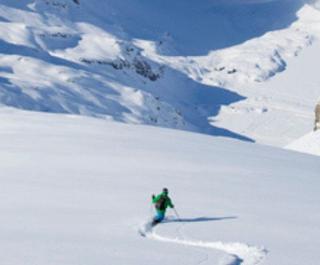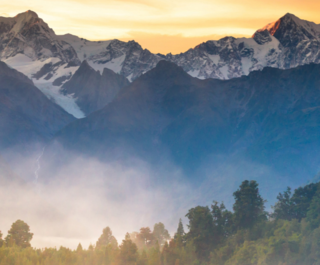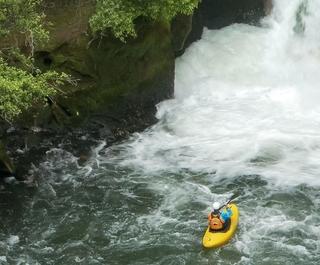
Nestling in the warm, sub-tropical waters 60 kilometres south of Kyushu, Japan’s third largest island, the towering mountains and ancient forests of Yakushima make it a secluded and largely unspoilt paradise, which feels a world away from the hustle and bustle of Japan’s megacities.
Designated a Unesco world heritage site in 1993, the island has long been revered by the Japanese as one of the country’s natural wonders, but it is only in recent years that foreign visitors have started to discover Yakushima’s secrets.
 Lush, lavish and green … A suspension bridge crossing a rainforest river on Yakushima (Image:Sara Winter/Getty)
Lush, lavish and green … A suspension bridge crossing a rainforest river on Yakushima (Image:Sara Winter/Getty)
This small, round island has an incredibly mountainous interior, but at only 27 kilometres wide, it is possible to see all of the main sights and get a good taste of island life in just a few days.
Miyanoura-dake (1,935 metres) is one of Japan’s famous One Hundred Mountains, and is the country’s most southerly point where snow can be found in winter.
But Yakushima is best known for the extensive and hauntingly beautiful forests that cover most of the island, home to Japanese cedar trees (known as Yakusugi), some of which are thousands of years old.
 Hiking trail near the top of Miyanoura-dake. (Image:Tom Fay)
Hiking trail near the top of Miyanoura-dake. (Image:Tom Fay)
Walking through these moody, temperate rainforests, full of fairytale-like trees with twisted moss-covered roots, it is no surprise to learn that the island was the inspiration for acclaimed Studio Ghibli animation Princess Mononoke, directed by Hayao Miyazaki.
The extremely wet climate means crystal-clear rivers tumble down from the high peaks, resulting in spectacular waterfalls, which carve their way through the granite bedrock.
Lavish green, dense foliage provides the perfect home for the Yakushima macaque and the Yaku deer, both of which are smaller than their mainland counterparts but less timid, so can easily be spotted foraging near roadsides and along hiking trails.
 A still from the Studio Ghibli production Princess Mononoke (AKA Mononoke-Hime). (Image: Rex/Shutterstock)
A still from the Studio Ghibli production Princess Mononoke (AKA Mononoke-Hime). (Image: Rex/Shutterstock)
In the summer months, endangered loggerhead turtles make their nests on Yakushima’s beaches, while tropical fish and corals can be found in the shallow and warm coastal waters. Geothermal hot springs (onsen) are everywhere, as they are in most of Japan, and some of the island’s best are right on the beach.
The two main points of entry are the tiny port towns of Miyanoura and Anbo, where daily ferries from Kagoshima put in.
Be sure to bring plenty of cash from the mainland as ATMs are almost non-existent and few places accept cards. A road loops around the entire island, although the western stretch is too narrow and remote for the (limited) bus service, so a rental car is the best way to get around.
What To See And Do
Outdoor activities are high on the agenda for most visitors to Yakushima, and the steep mountains and pristine forests attract hikers from all over Japan, with trails to suit all abilities.
Yakusugi Land, a nature park, (two buses a day from Anbo, ticket A$10) is home to many impressive old cedars, and has a number of easy hikes (ranging from 30 minutes to three hours), which afford close-up views of these relics.
 A Yakushima macaque. (Image: Aflo/Corbis)
A Yakushima macaque. (Image: Aflo/Corbis)
Further north, Shiratani Unsuikyo (35 minutes from Miyanoura by bus, ticket A$7) is a world of mossy-green woods and babbling streams that inspired Miyazaki’s animated masterpiece. The well-marked paths lead to a number of ancient, individually named cedars.
For the more adventurous, this area marks the beginning (or end) of a gruelling three-day traverse across the island’s interior, passing landmarks, such as Wilson’s Stump (the hollow remains of a long-felled giant cedar) and the oddly-shaped granite outcrops that characterise the high mountain tops.
There are a number of huts to stay in, for free, but you need to bring your own sleeping bag and cooking equipment as accommodation is extremely basic (and cold at night).
 Trunk call … the famous felled cedar of Wilson’s Stump. (Image: Takashi Yagihashi/amanaimages/Corbis)
Trunk call … the famous felled cedar of Wilson’s Stump. (Image: Takashi Yagihashi/amanaimages/Corbis)
See the squid that glow in the dark. Japan’s Mysterious Glowing Squid
Hot and cold in Kinosaki. Snow Crabs & Hot Springs In Kinosaki, Japan
For those who love soaking in hot springs, the unique Hirauchi Kaichu Onsen on the south coast is a must.
It’s right on the rocky shoreline and so can only be accessed twice a day, when the tide is low. Pop ¥100 (A$1) into the honesty box, strip down (a small towel can be used to protect your modesty) and be sure to follow local etiquette by rinsing yourself before entering the pools.
Just down the road is Yudomari Onsen, which has a bamboo divider to separate the sexes and, for those who can’t stand the heat, the water here is a pleasant 38C.
In summer, loggerhead turtles return to the place they were born some 30 years earlier to lay eggs on the beach. For night-time turtle watching with a local guide, make a reservation at the sea turtle museum.
There are exceptionally good snorkelling and sea-kayaking spots all around the island. As the rainiest place in Japan, waterfalls are ubiquitous and the most spectacular is the west coast’s 88-metre Ooko-no-taki, just a short walk from the main road.
 Bathers enjoy an onsen by the shore. (Image: Alamy)
Bathers enjoy an onsen by the shore. (Image: Alamy)
Where to eat and drink
There is no shortage of good food on Yakushima but, as with many out-of-the-way places in Japan, restaurants tend to close early. Seafood is the staple cuisine and is as fresh as it comes.
Lean, locally sourced deer is the main meat option in any season, delicious grilled over charcoal, yakiniku-style.
Should you crave fast food, there is a tiny Mos Burger in Anbo, surely the most rustic branch of this Japanese burger chain in the country.
If visiting in the winter, keep your eyes peeled for small roadside stalls selling bags of ponkan and tankan, sweet and juicy varieties of oranges grown all over the island. Also, be sure to try the potent yet delicate local Mitake shochu, a distilled, sweet-potato relative of sake, best served on the rocks.
For visitors fresh off the ferry, Shiosai (lunch sets from A$15) is a popular seafood restaurant just a short walk down the main street from Miyanoura port. The seasonal mackerel sashimi is a Yakushima speciality, and the fried flying fish (tobiuo) is another local favourite.
Lunchtime sets are reasonably priced and typically offer a choice of sashimi or fried fish in a light tempura batter, both served with a small salad and miso soup. Popular with locals and tourists alike, an English menu is available.
Rengaya in Anbo (sets from A$10, dinner from around A$35) is a lively establishment most well-known for its platters of deer meat and vegetables, which guests cook over a smoky grill in the centre of the table.
After a long day in the mountains, stretch your legs out on the tatami mats (no chairs here) and wash everything down with a cold beer or refreshing chuhai (a carbonated alcoholic drink).
On the main road in Anbo, Kamogawa is a cosy, family-run restaurant that offers satisfyingly large seafood sets at very reasonable prices.
Visit your local Flight Centre store or call 131 600 for more advice and the latest deals on travelling to Yakushima.
This article originally appeared on guardian.co.uk
This article was written by Tom Fay from The Guardian and was legally licensed through the NewsCred publisher network.










